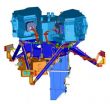(Press-News.org) BUFFALO, N.Y. -- Biomedical researchers at the University at Buffalo have engineered adult stem cells that scientists can grow continuously in culture, a discovery that could speed development of cost-effective treatments for diseases including heart disease, diabetes, immune disorders and neurodegenerative diseases.
UB scientists created the new cell lines – named "MSC Universal" – by genetically altering mesenchymal stem cells, which are found in bone marrow and can differentiate into cell types including bone, cartilage, muscle, fat, and beta-pancreatic islet cells.
The researchers say the breakthrough overcomes a frustrating barrier to progress in the field of regenerative medicine: The difficulty of growing adult stem cells for clinical applications.
Because mesenchymal stem cells have a limited life span in laboratory cultures, scientists and doctors who use the cells in research and treatments must continuously obtain fresh samples from bone marrow donors, a process both expensive and time-consuming. In addition, mesenchymal stem cells from different donors can vary in performance.
The cells that UB researchers modified show no signs of aging in culture, but otherwise appear to function as regular mesenchymal stem cells do – including by conferring therapeutic benefits in an animal study of heart disease. Despite their propensity to proliferate in the laboratory, MSC-Universal cells did not form tumors in animal testing.
"Our stem cell research is application-driven," says Techung Lee, PhD, UB associate professor of biochemistry and biomedical engineering in the School of Medicine and Biomedical Sciences and the School of Engineering and Applied Sciences, who led the project. "If you want to make stem cell therapies feasible, affordable and reproducible, we know you have to overcome a few hurdles. Part of the problem in our health care industry is that you have a treatment, but it often costs too much. In the case of stem cell treatments, isolating stem cells is very expensive. The cells we have engineered grow continuously in the laboratory, which brings down the price of treatments."
UB has applied for a patent to protect Lee's discovery, and the university's Office of Science, Technology Transfer and Economic Outreach (UB STOR) is discussing potential license agreements with companies interested in commercializing MSC-Universal.
Stem cells help regenerate or repair damaged tissues, primarily by releasing growth factors that encourage existing cells in the human body to function and grow.
Lee's ongoing work indicates that this feature makes it feasible to repair tissue damage by injecting mesenchymal stem cells into skeletal muscle, a less invasive procedure than injecting the cells directly into an organ requiring repair. In a rodent model of heart failure, Lee and collaborators showed that intramuscular delivery of mesenchymal stem cells improved heart chamber function and reduced scar tissue formation.
UB STOR commercialization manager Michael Fowler believes MSC-Universal could be key to bringing new regenerative therapies to the market. The modified cells could provide health care professionals and pharmaceutical companies with an unlimited supply of stem cells for therapeutic purposes, Fowler says.
Lee says his research team has generated two lines of MSC-Universal cells: a human line and a porcine line. Using the engineering technique he and colleagues developed, scientists can generate an MSC-Universal line from any donor sample of mesenchymal stem cells, he says. "I imagine that if these cells become routinely used in the future, one can generate a line from each ethnic group for each gender for people to choose from," Lee says.
INFORMATION:
The research was funded by the National Institutes of Health and New York State Stem Cell Science (NYSTEM).
The University at Buffalo is a premier research-intensive public university, a flagship institution in the State University of New York system and its largest and most comprehensive campus. UB's more than 28,000 students pursue their academic interests through more than 300 undergraduate, graduate and professional degree programs. Founded in 1846, the University at Buffalo is a member of the Association of American Universities.
Researchers engineer adult stem cells that do not age
2010-10-02
ELSE PRESS RELEASES FROM THIS DATE:
Mayo Clinic review of ethical decision making with end-of-life care
2010-10-02
ROCHESTER, Minn. -- In a review article published in the October issue of Mayo Clinic Proceedings,(http://www.mayoclinicproceedings.com) Mayo Clinic physicians differentiate the ethical and legal permissibility of withholding or withdrawing life-sustaining treatments and accepted comfort measures, specifically palliative sedation, from that of physician-assisted suicide or euthanasia.
Physician reviewers find that palliative sedation has an important place on the continuum of appropriate palliative care. "At the end of life, patient goals often shift to comfort, and removal ...
Climate change forcing a 'move it or lose it' approach to species conservation?
2010-10-02
What does it take to save a species in the 21st century? The specter of climate change, with predicted losses to biodiversity as high as 35 percent, has some scientists and managers considering taking their conservation strategies on the road.
Managed relocation (MR) is literally the physical relocation of endangered or threatened species of plants and animals, by humans, to new, and foreign geographical climes. It addresses the concern that climate shifts may make many species' historical ranges environmentally inhospitable, and that the rapid speed of change and habitat ...
GOES-13 sees an unholy matrimony: Nicole and low pressure swamp the US East Coast
2010-10-02
In a "marriage" that U.S. east coast residents would object to, the remnants of Tropical Storm Nicole coupled with an upper level low pressure area have dumped record rainfall from the Carolinas to New England on Sept. 30. The GOES-13 Satellite captured that massive "union" of a system as it begins to push off the northeastern U.S. coast today, Oct. 1.
At 1401 UTC (10:01 a.m. EDT) on Oct. 1, the Geostationary Operational Environmental Satellite called GOES-13 captured a visible image of the extensive cloud cover of this coupled system. The GOES image shows the system's ...
NASA's Webb telescope MIRI instrument takes one step closer to space
2010-10-02
A major instrument due to fly aboard NASA's James Webb Space Telescope is getting its first taste of space in the test facilities at the Rutherford Appleton Laboratory (RAL) in the United Kingdom. The Mid-InfraRed Instrument (MIRI) has been designed to contribute to areas of investigation as diverse as the first light in the early Universe and the formation of planets around other stars.
"The start of space simulation testing of the MIRI is the last major engineering activity needed to enable its delivery to NASA. It represents the culmination of 8 years of work by the ...
Computer-aided detection is increasingly being used in screening and diagnostic mammography
2010-10-02
The use of computer-aided detection (CAD) is increasing, in both screening and diagnostic mammography, according to a study in the October issue of the Journal of the American College of Radiology (www.jacr.org). CAD software systems highlight and alert the radiologist of abnormal areas of density, mass or calcification on a digitized mammographic image (of the breast) that may indicate the presence of cancer.
Screening mammography is an X-ray exam of the breast that is used as a screening tool to detect early breast cancer in women experiencing no symptoms. Diagnostic ...
Measuring productivity helps radiology department improve efficiency
2010-10-02
Researchers working in a radiology department at a mid-sized hospital were able to increase productivity and improve efficiency by developing a simple method for measuring general technologist productivity, according to a study in the October issue of the Journal of the American College of Radiology (www.jacr.org).
"Improving productivity and maintaining team spirit are often competing priorities that may be difficult to achieve simultaneously," said C. Daniel Johnson, MD, co-author of the study. "In an era of cost reductions, radiology departments need to be able to ...
October 2010 Geosphere highlights
2010-10-02
Boulder, CO, USA - This month's themed issue, "Advances in 3D imaging and analysis of geomaterials," edited by Guilherme A.R. Gualda, Don R. Baker, and Margherita Polacci, features papers from the 2009 AGU Joint Assembly session "Advances in 3-D Imaging and Analysis of Rocks and Other Earth Materials." Studies include 3-D imaging and analysis techniques for Wild 2 comet material returned from the NASA Stardust mission and the first 3-D X-ray scans of crystals from the Dry Valleys, Antarctica.
Introduction: Advances in 3D imaging and analysis of geomaterials
Guilherme ...
Evaluation of targeted therapy in ovarian cancer
2010-10-02
Reston, Va.— Research reported in the October issue of The Journal of Nuclear Medicine (JNM) shows that a molecular imaging technique may prove useful in early assessment of treatment response for cisplatin-resistant ovarian cancer.
"One of the most promising aspects of molecular imaging is its potential capacity to measure therapy effects long before changes in the tumor size and shape are detected," said Marijke De Saint-Hubert, medical scientist in the Department of Nuclear Medicine at the University Hospital Gasthuisberg, Leuven, Belgium, and one of the authors on ...
Parkinson's disease: Excess of special protein identified as key to symptoms and possible new target for treatment with widely used anti-cancer drug imatinib
2010-10-02
Johns Hopkins scientists have discovered that the over-activation of a single protein may shut down the brain-protecting effects of a molecule and facilitate the most common form of Parkinson's disease. The finding of this mechanism could lead to important new targets for drugs already known to inhibit it, thus controlling symptoms of the disorder, which affects about 1 million older Americans.
Previous research demonstrated that a protein called parkin protects brain cells by "tagging" certain toxic elements that are then destroyed naturally. It was also known that ...
Johns Hopkins researchers turn off severe food allergies in mice
2010-10-02
Johns Hopkins Medicine
Johns Hopkins scientists have discovered a way to turn off the immune system's allergic reaction to certain food proteins in mice, a discovery that could have implications for the millions of people who suffer severe reactions to foods, such as peanuts and milk.
The findings, published online in the journal Nature Medicine, provide hope that the body could be trained to tolerate food allergies that lead to roughly 300,000 emergency room visits and 100 to 200 deaths each year.
The research team, led by Shau-Ku Huang, Ph.D., a professor of medicine, ...


